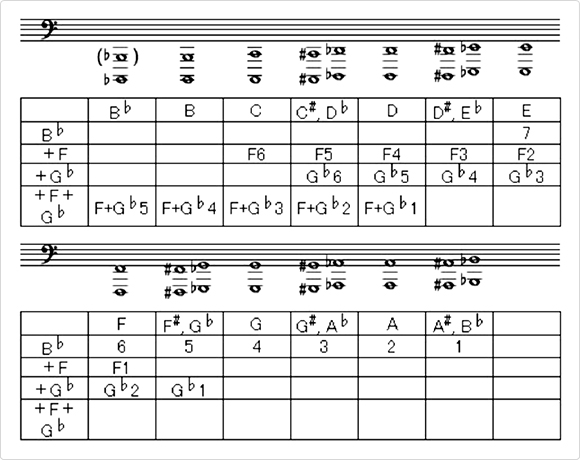When a valve is used the slide positions are longer (farther) than on an instrument without a valve.
For example, on an instrument with an in-line double rotary valve, if valve #1 is an F attachment and valve #2 is a G♭ attachment, what will happen if a sound lower than B♭ is played? Take a look at the position diagram.
How to Play the Trombone
Playing a tenorbass trombone or bass trombone
The positions change on instruments with valves
When set to F, the slide is reduced to six positions over the entire length of the slide. Using valve #2, or both valve #1 and valve #2, will similarly change the location of the slide positions. It all depends on how the instrument is played, its specifications, and its settings, so it is best to use a tuner or the like to confirm your own playing positions.
The lowest note produced by a tenorbass trombone
Theoretically, a tenorbass trombone should normally be capable of playing as low as C three octaves down from middle C (a minor seventh lower than pedal tone B♭). Some manufacturers have released instruments where a half-tone can be taken from the F attachment, making it an E attachment. In this case, the lowest note would be different.
A bass trombone with double rotary valves and equipped with an F attachment and G♭ attachment should theoretically be capable of playing B♭ a further major second lower (an octave lower than pedal tone B♭).
In either case, the slide will have a larger range than the normal seven positions.
Position to produce the pedal tone
It is notoriously difficult to produce the pedal tone (fundamental tone) with a trombone. This is not the case with a tenor trombone.

A tenorbass trombone has only a single valve (F attachment), so B♭ and F on the position chart can be used as shown.
High note positions
The positions from 9th harmonic series H to 12th harmonic series F are shown to the right.

All notations are actual notes, and the numbers in parentheses show typical switching positions. Note that there are many switching positions in the high-tone range, and others may be used to play this. For any other note, you can use the same position as the note one octave below it.
Musical Instrument Guide:Trombone Contents
Structure
How to Play
How the Instrument is Made
Choosing an Instrument
Care and Maintenance
Trivia
- God is in the trombone
- The trombone was a bit of a problem for cavalries...
- A trombone that would scare even a snake!
- Two instruments, both tenor, but quite different!
- A trombone player walks into pawnshop...
- You can trill just by moving your mouth
- It is possible to increase the pitch even as you extend the slide
- Famous pieces from trombone concertos
- Orchestra pieces in which the trombone plays an important role
- The Yamaha quartet
- For trombones, why does sheet music notation differ from the fundamental tone of the instrument?
- A bass trombone-with an F attachment only
